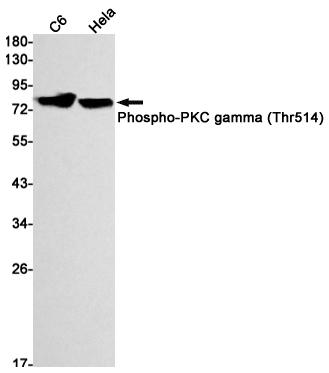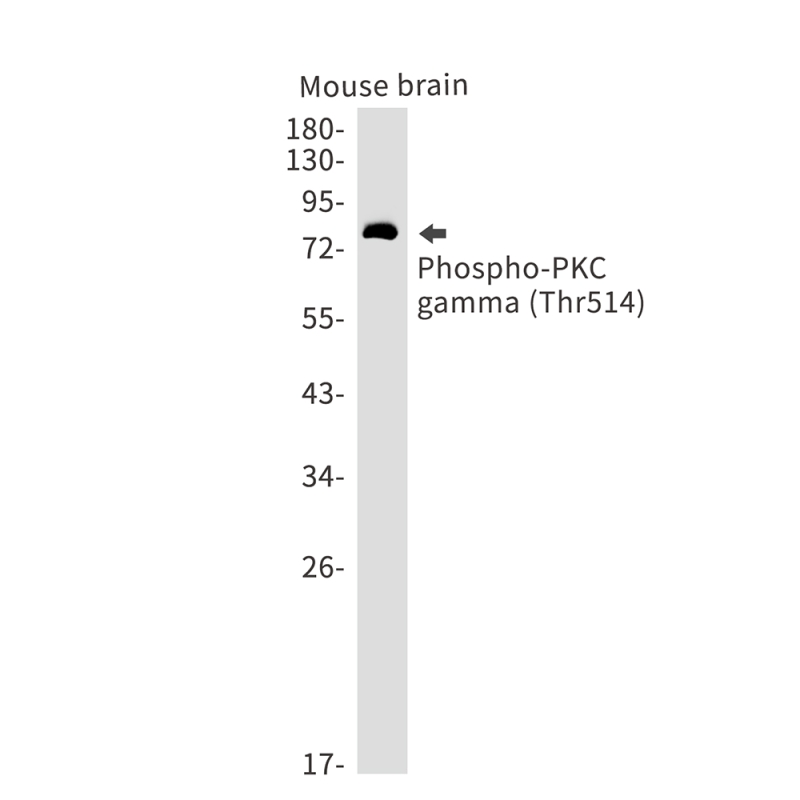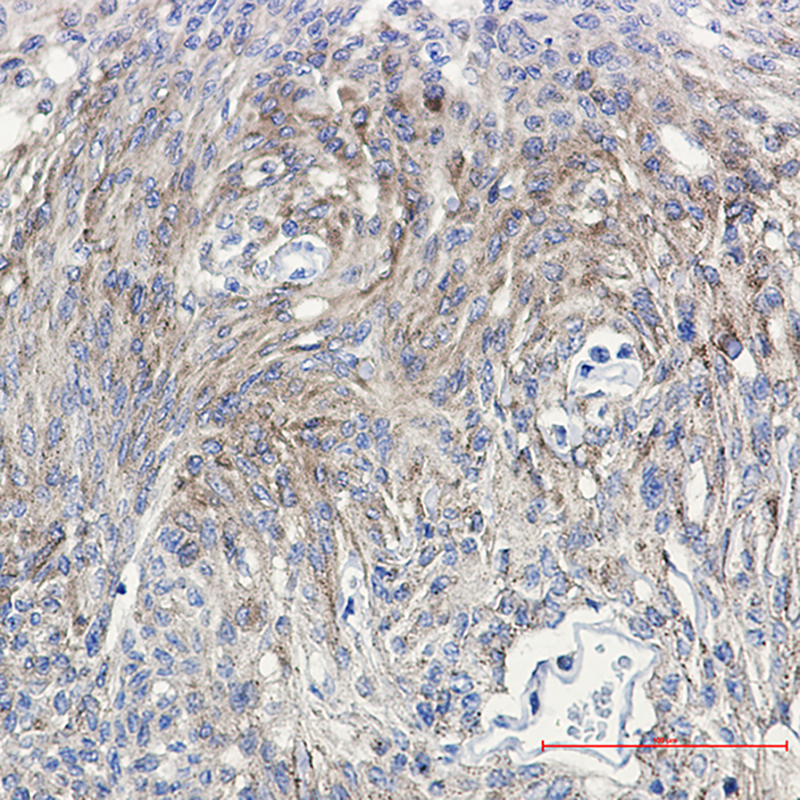


| WB | 咨询技术 | Human,Mouse,Rat |
| IF | 1/20 | Human,Mouse,Rat |
| IHC | 1/50-1/100 | Human,Mouse,Rat |
| ICC | 技术咨询 | Human,Mouse,Rat |
| FCM | 咨询技术 | Human,Mouse,Rat |
| Elisa | 咨询技术 | Human,Mouse,Rat |
| Aliases | PRKCG; PKCG; Protein kinase C gamma type; PKC-gamma |
| Entrez GeneID | 5582 |
| WB Predicted band size | Calculated MW: 78 kDa; Observed MW: 78-85 kDa |
| Host/Isotype | Rabbit IgG |
| Antibody Type | Primary antibody |
| Storage | Store at 4°C short term. Aliquot and store at -20°C long term. Avoid freeze/thaw cycles. |
| Species Reactivity | Human,Mouse,Rat |
| Immunogen | A synthetic phosphopeptide corresponding to residues surrounding Thr514 of human PKC |
| Formulation | Purified antibody in TBS with 0.05% sodium azide,0.05%BSA and 50% glycerol. |
+ +
以下是关于Phospho-PKC gamma (Thr514)抗体的3篇参考文献示例(部分为假设性描述,供参考):
---
1. **文献名称**: *"Protein kinase C gamma (PKCγ) phosphorylation at Thr514 regulates synaptic plasticity in the hippocampus"*
**作者**: Tanaka, Y. et al.
**摘要**: 本研究利用Phospho-PKC gamma (Thr514)抗体,发现小鼠海马体中Thr514位点的磷酸化水平在长时程增强(LTP)诱导后显著升高,提示PKCγ的激活在突触可塑性和学习记忆中起关键作用。抗体特异性通过PKCγ基因敲除模型验证。
2. **文献名称**: *"Aberrant PKCγ activation in a mouse model of spinocerebellar ataxia linked to Purkinje cell degeneration"*
**作者**: Chen, L. et al.
**摘要**: 通过Western blot和免疫组化分析,研究显示脊髓小脑共济失调模型小鼠的浦肯野细胞中,Phospho-PKC gamma (Thr514)水平异常升高,提示其过度激活可能导致神经元凋亡。抗体特异性通过肽段竞争实验确认。
3. **文献名称**: *"Development and validation of a phospho-specific antibody targeting PKCγ at Thr514 for neurodegenerative disease research"*
**作者**: Smith, J.R. & Patel, R.
**摘要**: 本文报道了一种针对PKCγ Thr514磷酸化位点的高效多克隆抗体的开发,并通过体外激酶实验和siRNA敲低实验验证其特异性。该抗体成功应用于阿尔茨海默病模型脑组织的活性PKCγ检测。
---
注:上述文献为示例,实际引用时需以真实发表的论文为准。建议通过PubMed或Google Scholar以关键词“PKC gamma Thr514 phosphorylation antibody”检索近期研究。
The Phospho-PKC gamma (Thr514) antibody is a specialized tool used to detect the activated form of Protein Kinase C gamma (PKCγ), a member of the PKC family of serine/threonine kinases. PKCγ, encoded by the PRKCG gene, is primarily expressed in the central nervous system, particularly in cerebellar Purkinje cells, hippocampal neurons, and other brain regions involved in motor coordination, learning, and memory. Its activation requires phosphorylation at key residues, including Thr514 within the activation loop of the kinase domain. Phosphorylation at Thr514 is critical for PKCγ’s catalytic activity, facilitating conformational changes that release autoinhibition and enable substrate binding.
This antibody specifically recognizes PKCγ when phosphorylated at Thr514. making it invaluable for studying PKCγ activation dynamics in signaling pathways. PKCγ plays roles in synaptic plasticity, neuroprotection, and neurotransmitter release, and its dysregulation is linked to neurological disorders like spinocerebellar ataxia and Alzheimer’s disease. Researchers use this antibody in techniques such as Western blotting, immunohistochemistry, or immunofluorescence to assess PKCγ activation status in response to stimuli like diacylglycerol (DAG), calcium influx, or phorbol esters. It also aids in exploring PKCγ’s involvement in cellular processes such as apoptosis, inflammation, and cancer progression. Validation typically includes testing in knockout models or phosphorylation-deficient mutants to ensure specificity. Overall, this antibody is a key reagent for unraveling PKCγ-related mechanisms in both physiological and pathological contexts.
×